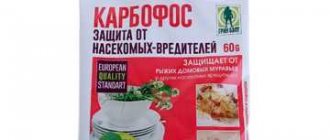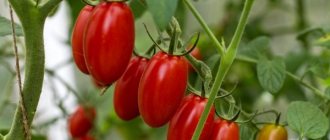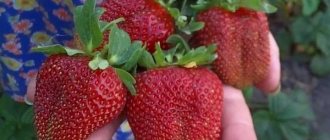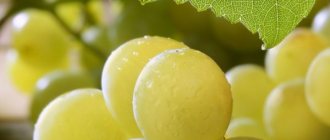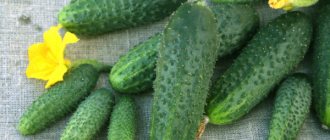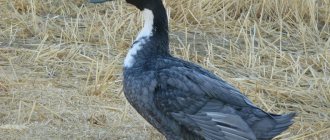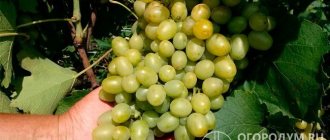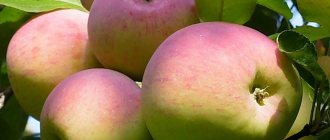Pear Just Maria.
Description of the variety
It’s just that Maria belongs to the varieties of autumn ripening. Pears of this variety can withstand frosts down to -38 degrees and are suitable for growing in regions with harsh climatic conditions.
Characteristics of wood
Trees of this variety are medium-sized and do not exceed 3 meters in height. The crown is wide, moderately dense, and has a pyramidal shape.
Description of fruits
Pear Just Maria.
Pears are large and weigh on average about 180-200 grams. The fruit shape is standard.
When ripe, pears are yellow-green in color, but as they ripen they turn light yellow. On the surface of the fruit there is a blurry pink blush and many small subcutaneous green dots.
Pears have a sweet, dessert taste, with a pleasant sourness and light aroma.
The fruits are removed from the tree in late September - early October. Consumer ripeness of pears occurs 3-4 weeks after picking. The harvested crop can be stored in the refrigerator until the end of January.
Growing process
To get a good harvest, carefully care for the plant, performing all the necessary procedures. This will accelerate the growth of the plant and allow you to obtain beautiful and juicy fruits every year.
Irrigation scheme
Water the newly planted plant every day, pouring 10 liters of water under it. Pear Simply Maria likes moisture, so water an adult plant several times during the season. Water after the snow melts, and then when the leaves unfurl. Also water the tree just before flowering.
In summer, watering depends on weather conditions. If there is severe drought, moisten the pear more often; if the summer is warm with sufficient rainfall, water the plant once a month.
The last watering is carried out in mid-September - it will protect the fruits from cracking, fill them with juice, and the soil will be moist.
Fertilizing
Apply fertilizer the second season after planting the tree. It’s just that Maria is a variety that responds well to natural organic fertilizers. At least once every three years, in the spring, when loosening, distribute humus or rotted compost into the tree trunk circle at the rate of 8-10 kg per 1 square meter. m. Apply mineral and nitrogen fertilizers annually – per 1 sq. m 10-15 g. It is permissible to divide the total norm into three feedings. In this case, apply nitrogen fertilizers after the leaves bloom, 10 days before flowering and immediately after it.
It is forbidden to apply nitrogen fertilizers at the same time as humus, otherwise this can lead to burning of the plant roots. Keep the minimum interval between feedings - 4-5 days.
7-10 days after flowering, the pear needs complex feeding. Use complex nitrogen-phosphorus-potassium preparations (Azofoska, Nitrophoska, Diammofoska) or special fertilizers for fruit trees (Gera, Master, Agricola). It is convenient to use natural fertilizer - infusion of mullein, bird droppings (25-30 liters per 1 adult plant).
During the summer, apply foliar fertilizing once a month. For 10 liters of water, take 25-30 g of potassium nitrate and simple superphosphate.
Pear pruning
An important stage in growing a pear is the formation of the crown:
- In the spring, before the sap begins to flow, carry out formative pruning. Leave several fruit shoots on one skeletal branch. Carry out the very first pruning immediately after planting the seedling.
- Shorten the central shoot by 15 cm, and trim all lateral branches to the growth point. Every year shorten the elongated crown to the tips of the uppermost tier of branches.
- Cut out all shoots growing inside the crown.
The pear tree does not branch much, so in the future carry out formative pruning as needed.
In the fall, sanitary pruning is required: cut out broken, diseased, dried and pest-damaged shoots. Carry out the procedure after harvesting and the leaves have fallen, when the plant is “sleeping”. After pruning, always treat the cuttings with garden varnish.
Preparing for winter
Simply Maria pear is considered a frost-resistant variety that can withstand severe frosts without damage. If you grow a tree in the Urals, you cannot do without shelter for the winter. The preparatory process consists of the following procedures:
- Clean the trunk circle. Remove all fallen fruit and leaves, broken branches and other debris.
- Renew the layer of mulch so that its thickness in the circle around the trunk is up to 10 cm, at the trunk itself - up to 25-30 cm. Use humus.
- Cover the trunk up to the first fork and the lower third of the skeletal branches with whitewash - it will protect the plant from rodents and sunburn.
- Wrap the base of the trunk with several layers of covering material that allows air to pass through well.
- When a lot of snow falls, rake it up to the trunk. During the winter, the snowdrift will gradually settle, so renew it several times, while simultaneously breaking up the hard crust on the surface.
Reviews
Vitaly
Tver
The tree is very resistant and is not afraid of any frost. In our area, the pear winters without shelter and no problems arise. The yield is good, but it is worth noting that I have three different varieties growing on my site that bloom at the same time.
Catherine
Mound
The variety is very good. In our climate, it is not easy to grow such large and tasty pears. Unlike other Siberian varieties, Simply Maria tolerates cold a little worse, but is significantly superior to them in terms of fruit quality.
Olga
Ussuriysk
This is one of the best varieties that can grow and bear fruit in the Far East. For our area, it is very rare that in your own garden you can pick such large and tasty pears from a tree.
Reproduction
There are several ways to propagate the Simply Maria pear: by cuttings, layering and grafting. Each method requires the fulfillment of certain requirements and rules.
Cuttings
This method is considered the most effective. Cut a green cutting with leaves from the tree. Treat it with root formation stimulants and keep it under a film cover until roots appear at a temperature of 20-25 degrees.
By layering
This procedure will not take much of your time. The propagation process is simple: bury part of the parent branch in nutritious, moist soil, saturated with oxygen, so that the top is located above the surface of the soil - it should receive sunlight.
Roots form in the place where the branch is covered with soil. No special care required. You just have to keep the soil moist. After the roots appear, cut off the layer from the mother branch with pruning shears and plant it as a seedling.
Vaccinations
This method is the most time-consuming and labor-intensive. Pear propagation by grafting is permissible when the movement of juice in the plant has not begun. To do this, prepare the cuttings in December and store them in a cool place. For this purpose, it is allowed to use one-year-old shoots with 3-4 eyes. In the spring, cuttings begin to be grafted. Use any variety of pear, game or apple tree as a rootstock.
Landing
Pear Simply Maria adapts well to different conditions and is unpretentious in choosing soil. In the articles below, you can find detailed instructions on planting seedlings.
How to plant a pear tree correctly
At what distance to plant pears?
How to choose pear seedlings
How to replant a pear
conclusions
- Simply Maria is a young autumn pear variety characterized by very high winter hardiness.
- The fruits of the tree have a very sweet, rich taste with barely noticeable sourness. Suitable for fresh consumption and as juice or jam. The latter can be cooked without sugar.
- The variety is medium-yielding - up to 40 kg per tree. Under favorable conditions, the yield can be increased to 50–60 kg.
- Maria just loves moisture. A young tree needs to be watered at least once every 1–2 weeks. An adult is watered at least 4 times per season.
- It’s just that Maria is resistant to diseases, but in conditions of high humidity she becomes sensitive to fungal diseases. The garden must be sprayed in the spring for preventive purposes.
- The pear needs feeding. During the season, the plant is fed at least 4 times. Both root and foliar feeding is used.
Care
For healthy growth and development, standard agricultural technology is sufficient for pears of this variety. By clicking on the links below, you can find many useful materials on the topic of growing Simply Maria trees.
How to care for a pear Pruning a pear Pruning a columnar pear Treating a pear from diseases and pests Feeding a pear How to water a pear
How to propagate pear?
Maria simply reproduces in the following ways:
- By cuttings.
A branch with leaves is cut from an adult tree and placed in a container of water. After a few weeks, the cutting produces roots. For better root formation, place a Heteroauxin tablet in the water. Then the cuttings are planted in the ground and watered abundantly. It is advisable to carry out this procedure in the summer. The cuttings can first be planted in a greenhouse. For better rooting, the plant is watered up to 4-5 times a day.
- By layering.
A branch of an adult tree is bent down and covered with earth. The soil is well irrigated with water; the soil can be loosened first. The top of the branch with leaves remains above the ground. Roots form at the point where the shoot touches the soil. When the branch is well rooted, it is cut off from the parent tree. The time of the procedure is the season of intensive growth (from mid-spring to late summer). Branches for layering should be young and not yet lignified.
- By grafting.
A cutting with dormant buds is cut from the mother tree. A sharp cut is made at one end and a blunt cut at the other. A thin branch with two or three unopened buds in early spring, at the moment the sap begins to flow, is grafted under the bark of a tree, for example, a pear of a different variety. You can insert the cutting into a rootstock cut in half. The tree branches into which cuttings from another tree are inserted are cut down to stumps. Then Simply Maria is implanted into them. The junction is tightly wrapped with tape.
Diseases and pests
The Simply Maria pear variety has good resistance to scab and, with proper care, practically does not get sick. To eliminate the risk of contracting other diseases, preventive maintenance should be carried out regularly. Recommendations for protecting plants from diseases can be found in the selection of articles below.
Dangerous Pear Pests
Pears often suffer from pests, they affect the leaves, bark and fruits.
In this article, we have selected 11 of the most harmful insects that harm pear trees, and also ways to destroy them.
Diseases of pear trees
To get what they cherish, gardeners have to work hard, and the reason for this is pear diseases.
Read about 19 common pear diseases and how to combat them.
Resistance to adverse factors
When describing a variety, the frost resistance of the pear is always indicated. In the southern part of the Moscow region it winters without problems; when grown north of the capital, it freezes slightly, but is much smaller than the control varieties and quickly recovers. Mature trees are highly resistant to drought.
Important! The fruits remain tasty even if the summer was cloudy.
The variety is affected by pests, like other pears. Shows resistance to the following tree and fruit diseases:
- scab;
- bacterial cancer;
- septoria.
Breeding history
The “Simply Maria” variety was created in Belarus at the former Belarusian Scientific Research Institute of Fruit Growing. The pear was obtained by crossing the “Oil Ro” variety and the hybrid form 6/89-100. The first seedling of the newly bred variety began to bear fruit in the research garden in the fifth year.
- 1996 The seedling was selected from among many, based on its yield, resistance to cold and the quality of the grown fruit. The variety was propagated on the seed rootstock of a forest pear and planted for further study of the variety.
- 2003 The seedling was identified as elite.
- 2005 year. The variety was submitted for State variety testing.

